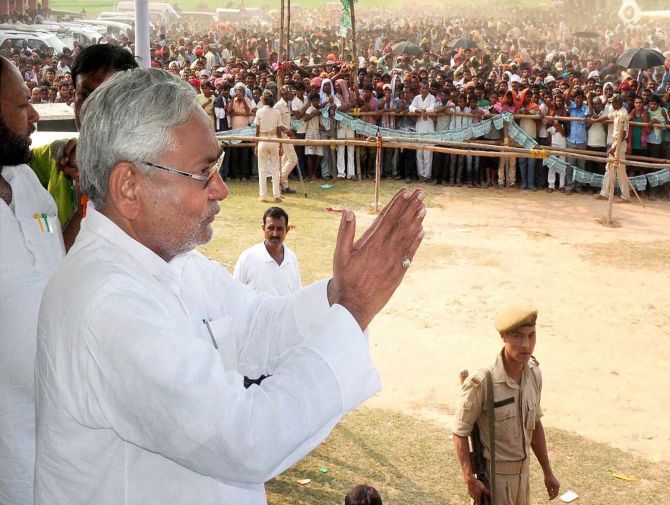"Governance, governance, governance," was what Nitish Kumar said were his three priorities when he took the helm of Bihar in 2005.

In 2005, just when Nitish Kumar had taken over as chief minister, one of his MLAs died of a heart attack. Being an MLA, he had to be given a state funeral with a five-gun salute. The body lay in state, awaiting the salute. Five guns were required to fire in the air. The first round went off perfectly. But in the second round, three rifles jammed and merely responded with an empty ‘click’ when fired. Policemen scurried to get rifles that would work. In the third and fourth round, only two rifles fired. In the fifth round, all the rifles jammed so bystanders saw, rather than heard, the rifles firing. Nitish was mortified. But that was what he had inherited: jammed guns and Remington typewriters. Little wonder then when he was asked what his top three priorities for the state were, he said: “Governance, governance, governance”.
For five years, Nitish worked tirelessly to devise a new strategy for Bihar that had slid on all metrics during the rule of Lalu Prasad and family for the previous 15 years. Some ideas were innovative, some just common sense. “The division of Bihar had cost us all the mining and mineral activity: everything had gone to Jharkhand. We had no industry. All we had was agriculture, tourism… and our human resource, the people of Bihar. So education was the only way to develop the state,” said a bureaucrat closely associated with the state’s educational reform.
Apart from law and order, if agri-produce was to be brought to the market, better and more roads were necessary. “In the first phase (2005-09), we built schools, roads, did health sector reforms. We had planned in the second phase to work on improving the quality of education, deepening power sector reforms, concentrating on IT,” said a bureaucrat.
The 2009 Lok Sabha elections reaffirmed that governance was a slogan that still worked and was not suborned by caste. Nitish led the National Democratic Alliance to victory in 32 of the state’s 40 Lok Sabha seats in 2009 and 206 of the 243 assembly seats in 2010.
Between 2010 and 2014, Bihar worked on improving the girl child’s access to education: the distribution of bicycles was hugely popular, first only for girls and then for the entire school-going population. Recruitment of teachers by the panchayat would lead to its own set of problems: but at that time, everything seemed to be going swimmingly.
Then disaster struck. Narendra Modi was made chief of the Bharatiya Janata Party’s campaign committee and it was clear that he would be the BJP’s prime ministerial candidate in the 2014 general elections. Although the Janata Dal-United, tried to keep a distance from the happenings within the BJP, it was clear that as an alliance partner, it would inevitably be affected.
The denouement came when Modi came to Bihar for a meeting of the national executive, a dinner was organised but Nitish sent a message that Modi (and Varun Gandhi) were not invited. Nitish’s reason was the advertisements sponsored by the BJP said Muslims in Gujarat were better off than in other states (ads did not name Bihar). The BJP rejected this condition and, finally, Nitish snapped ties with the BJP.
The 2014 election results were cataclysmic for the JD-U. It got two seats out of 40. Nitish thought he could shrug the BJP and the people of Bihar would still vote for him because of his good governance. But the verdict was the opposite.
Worse, everywhere else in India, regional leaders -- from Mamata Banerjee to Naveen Patnaik -- did not lose the election; only Nitish did. “He couldn’t understand. He had done so much for people. Everyone told him: ‘The thinking is different in Lok Sabha elections and different in Vidhan Sabha elections. For the Lok Sabha, people might vote for Modi but in state elections, they will vote for you’. But it was as if a dam had broken,” said a bureaucrat associated with that phase of reforms.
In panic, Nitish decided to resort to the lowest common multiple of Bihar politics: caste. He quit the chief ministership, installed a Dalit Musahar, Jitan Ram Manjhi, as CM, and held out a hand to oldest foes Prasad and the Congress and created a caste alliance that, arithmetically at least, looked invincible.
In the Lok Sabha election, the aggregate vote share of these parties had crossed 41 per cent. But there was widespread dismay among people. Nitish could not -- and did not -- say the alliance was only tactical. Because of his prison term in the fodder scam conviction, Lalu had been outlawed from contesting elections forever. But the anti-Yadav castes which had figured prominently in Nitish’s earlier coalition could only see empowerment of the Yadavs who had been out of the power loop for 10 years and were yearning to return. There is a tiny section of the Yadavs that believes Lalu’s greatest weakness is the promotion of his own family (two of his sons are contesting this election) and that he needs to be stopped. Among this lot is Pappu Yadav who is contesting from Kosi against Lalu’s parivarvaad. But most Yadavs still consider Lalu their unquestioned leader.
Moreover, it was not just the Yadavs that Lalu was bringing to the table -- it was also the Muslims. Although a section of Muslims had voted for Nitish even when he was with the BJP, with Lalu, there was a reason to vote en bloc against the BJP. However, the extremely backward classes and the poorest among Dalits were unconvinced. Depending on the region, it was the Yadavs and the upper caste Bhumihars that were their greatest oppressors. Now, not only was Nitish bringing that very caste, Yadav, into the alliance but had already favoured Bhumihars by appointing Bhumihar officers as his most trusted bureaucrats. So when it came to a crunch, where would EBCs go for justice if the Nitish-Lalu combine came to power? Worse followed even as they were mulling this: Nitish realised Jitan Ram Manjhi wasn’t making the cut in governance. So he sacked him and re-appointed himself as CM. Humiliated, Manjhi went to the BJP which welcomed him with open arms. During this period, there was virtually no governance initiative. “The new bridge over the Ganga is almost ready. But Nitish is delaying inaugurating it because he doesn't want Manjhi to get the credit,” say BJP leaders.
But away from the noise of the election, there is acceptance that Nitish put in motion a process -- admittedly from a very low base -- that put Bihar on a definite trajectory. “Even among the developed states, there is no government that spends 24 per cent of its Budget on education -- we do. There is now a school within one kilometre of every village. The school is the hub of all activity. We concede that in Bihar, we cannot dream of big industry -- land is too difficult to acquire. But we can promote tourism; we can promote IT and most of all, education… You will not see the results of this path of development immediately. But in the future, not only literacy, but the quality of literacy, too, will improve,” says a bureaucrat.
For now, Nitish is fighting back grimly but is convinced that whatever the hue of the government, his is the road that it will have to take.










 © 2025
© 2025